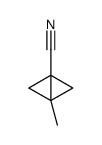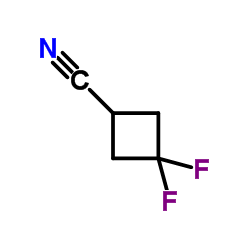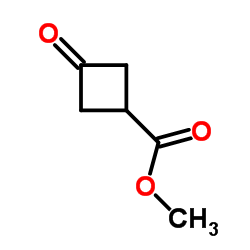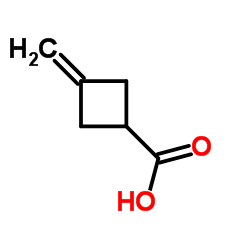15760-35-7
| Name | 3-Methylenecyclobutane-1-Carbonitrile |
|---|---|
| Synonyms |
3-Methylene-cyclobutanecarbonitrile
3-Methylenecyclobutanecarbonitrile Cyclobutanecarbonitrile, 3-methylene- 3-Methylene-1-cyanocyclobutane MFCD01085401 3-Methylenecyclobutane-carbonitrile 3-methylidenecyclobutane-1-carbonitrile |
| Density | 0.9±0.1 g/cm3 |
|---|---|
| Boiling Point | 171.7±29.0 °C at 760 mmHg |
| Melting Point | 149-150ºC |
| Molecular Formula | C6H7N |
| Molecular Weight | 93.127 |
| Flash Point | 51.8±17.1 °C |
| Exact Mass | 93.057846 |
| PSA | 23.79000 |
| LogP | 0.79 |
| Vapour Pressure | 1.4±0.3 mmHg at 25°C |
| Index of Refraction | 1.466 |
Synonym: Section 2 - COMPOSITION, INFORMATION ON INGREDIENTS
Risk Phrases: 20/21/22 Section 3 - HAZARDS IDENTIFICATION EMERGENCY OVERVIEW
Harmful by inhalation, in contact with skin and if swallowed. Potential Health Effects Eye: May cause eye irritation. Skin: May cause skin irritation. Harmful if absorbed through the skin. Ingestion: Harmful if swallowed. May cause irritation of the digestive tract. Inhalation: Harmful if inhaled. May cause respiratory tract irritation. Chronic: Not available. Section 4 - FIRST AID MEASURES Eyes: Flush eyes with plenty of water for at least 15 minutes, occasionally lifting the upper and lower eyelids. Get medical aid. Skin: Get medical aid. Flush skin with plenty of water for at least 15 minutes while removing contaminated clothing and shoes. Ingestion: Get medical aid. Wash mouth out with water. Inhalation: Remove from exposure and move to fresh air immediately. If not breathing, give artificial respiration. If breathing is difficult, give oxygen. Get medical aid. Notes to Physician: Section 5 - FIRE FIGHTING MEASURES General Information: As in any fire, wear a self-contained breathing apparatus in pressure-demand, MSHA/NIOSH (approved or equivalent), and full protective gear. Extinguishing Media: Use water spray, dry chemical, carbon dioxide, or chemical foam. Section 6 - ACCIDENTAL RELEASE MEASURES General Information: Use proper personal protective equipment as indicated in Section 8. Spills/Leaks: Absorb spill with inert material (e.g. vermiculite, sand or earth), then place in suitable container. Section 7 - HANDLING and STORAGE Handling: Avoid breathing dust, vapor, mist, or gas. Avoid contact with skin and eyes. Storage: Store in a cool, dry place. Store in a tightly closed container. Section 8 - EXPOSURE CONTROLS, PERSONAL PROTECTION Engineering Controls: Use adequate ventilation to keep airborne concentrations low. Exposure Limits CAS# 15760-35-7: Personal Protective Equipment Eyes: Not available. Skin: Wear appropriate protective gloves to prevent skin exposure. Clothing: Wear appropriate protective clothing to prevent skin exposure. Respirators: Follow the OSHA respirator regulations found in 29 CFR 1910.134 or European Standard EN 149. Use a NIOSH/MSHA or European Standard EN 149 approved respirator if exposure limits are exceeded or if irritation or other symptoms are experienced. Section 9 - PHYSICAL AND CHEMICAL PROPERTIES Physical State: Liquid Color: colorless Odor: Not available. pH: Not available. Vapor Pressure: Not available. Viscosity: Not available. Boiling Point: Not available. Freezing/Melting Point: Not available. Autoignition Temperature: Not available. Flash Point: Not available. Explosion Limits, lower: Not available. Explosion Limits, upper: Not available. Decomposition Temperature: Solubility in water: Specific Gravity/Density: Molecular Formula: C6H7N Molecular Weight: 93 Section 10 - STABILITY AND REACTIVITY Chemical Stability: Not available. Conditions to Avoid: Incompatible materials. Incompatibilities with Other Materials: Oxidizing agents, reducing agents. Hazardous Decomposition Products: Hydrogen cyanide, nitrogen oxides, carbon monoxide, carbon dioxide. Hazardous Polymerization: Has not been reported Section 11 - TOXICOLOGICAL INFORMATION RTECS#: CAS# 15760-35-7: GU1300000 LD50/LC50: Not available. Carcinogenicity: 3-Methylenecyclobutanecarbonitrile - Not listed by ACGIH, IARC, or NTP. Other: See actual entry in RTECS for complete information. Section 12 - ECOLOGICAL INFORMATION Section 13 - DISPOSAL CONSIDERATIONS Dispose of in a manner consistent with federal, state, and local regulations. Section 14 - TRANSPORT INFORMATION IATA Shipping Name: NITRILES, LIQUID, TOXIC, N.O.S.* Hazard Class: 6.1 UN Number: 3276 Packing Group: III IMO Shipping Name: NITRILES, TOXIC, N.O.S. Hazard Class: 6.1 UN Number: 3276 Packing Group: III RID/ADR Shipping Name: NITRILES, TOXIC, N.O.S. Hazard Class: 6.1 UN Number: 3276 Packing group: III Section 15 - REGULATORY INFORMATION European/International Regulations European Labeling in Accordance with EC Directives Hazard Symbols: XN Risk Phrases: R 20/21/22 Harmful by inhalation, in contact with skin and if swallowed. Safety Phrases: S 36/37 Wear suitable protective clothing and gloves. WGK (Water Danger/Protection) CAS# 15760-35-7: No information available. Canada None of the chemicals in this product are listed on the DSL/NDSL list. CAS# 15760-35-7 is not listed on Canada's Ingredient Disclosure List. US FEDERAL TSCA CAS# 15760-35-7 is not listed on the TSCA inventory. It is for research and development use only. SECTION 16 - ADDITIONAL INFORMATION N/A |
CHEMICAL IDENTIFICATION
HEALTH HAZARD DATAACUTE TOXICITY DATA
|
| Hazard Codes | Xn:Harmful; |
|---|---|
| Risk Phrases | R20/21/22 |
| Safety Phrases | S36/37 |
| RIDADR | UN 3276 |
| Hazard Class | 3,6.1 |
| HS Code | 2926909090 |
|
~% 
15760-35-7 |
| Literature: Journal of the American Chemical Society, , vol. 80, p. 5507,5512 Journal of the American Chemical Society, , vol. 81, p. 2723,2725 |
|
~14% 
15760-35-7
Detail
|
| Literature: Journal of Organic Chemistry, , vol. 51, # 24 p. 4537 - 4544 |
|
~% 
15760-35-7
Detail
|
| Literature: Journal of the American Chemical Society, , vol. 81, p. 2723,2725 |
| Precursor 4 | |
|---|---|
| DownStream 10 | |
| HS Code | 2926909090 |
|---|---|
| Summary | HS:2926909090 other nitrile-function compounds VAT:17.0% Tax rebate rate:9.0% Supervision conditions:none MFN tariff:6.5% General tariff:30.0% |








![3-phenylbicyclo[1.1.0]butane-1-carbonitrile structure](https://image.chemsrc.com/caspic/147/30494-27-0.png)







